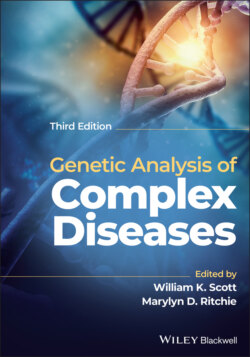Читать книгу Genetic Analysis of Complex Disease - Группа авторов - Страница 67
Extended Families
ОглавлениеExtended families refer to large families with many affected individuals in several generations. This study design is optimal for traditional linkage analysis but is often a rare occurrence in complex disorders. If such a family is identified, it is possible that the genetic liability in this particular family is due to a single gene, rather than a more complex etiology. Such a family would provide a unique opportunity to localize a single gene that has a large effect on disease risk in that family but may have a more moderate effect on disease etiology in the general population. Advances in high‐throughput sequencing technologies (described more in Chapter 10) have made genome sequencing of small numbers of affected family members feasible, allowing the direct examination of segregation of variants with disease in these pedigrees (described more in Chapter 6). Association methods may also be used with extended families. However, one must ensure that the association method being used considers the within‐family dependence (such as the Pedigree Disequilibrium Test (Martin et al. 2000b) or GenABEL (Aulchenko et al. 2007)) or selects only one affected individual from the family to be used in the analysis. A special case can be made for analyzing X‐linked variants within families (Choi et al. 2016; Turkmen and Lin 2020).
There are also variations on these three ascertainment schemes. For example, in an analysis of breast cancer in Australia, Hopper and colleagues (1999) employed a “case‐control‐family” design. In this approach, the cases and controls were selected first and subsequently additional family members were recruited based on the family history. If applied correctly, this approach will have the analytic advantages of a family study, and the results can be placed in the context of an epidemiologic study. Statistical issues associated with this design have been reviewed by other investigators (Liang and Pulver 1996; Seybolt et al. 1997) and will not be discussed here.
Many investigators have explored sampling schemes to determine the optimal ascertainment scheme for genetic analysis of complex disorders. McCarthy and colleagues (1998) considered sampling strategies for affected sibpairs and found that the power to detect a disease gene locus is highly dependent on the larger pedigree structure from which the sibpairs were drawn. Furthermore, they concluded that imposing a few restrictions on that pedigree structure (such as the presence of at least one unaffected sibling or parent) can provide a modest increase in power, and ascertaining random affected sibpairs (regardless of the larger pedigree structure) tends to be a robust approach under a variety of genetic inheritance models. The advantage of restricting the pedigree structure to one or fewer affected parents is that one can reduce the possibility of bilineality in the pedigree. Terwilliger and Goring (2000) have argued that, even in the case of complex disorders, ascertainment of large pedigrees is a more successful approach for genetic analysis than a case‐control approach as the large pedigrees increase the likelihood of genetic homogeneity and additionally, once ascertaining large pedigrees, one has more flexibility with regard to the types of analyses that may be performed. For example, one can analyze the entire pedigree for linkage analysis, and also, by breaking the family structure into smaller units, consider affected sibpair, affected relative pair, or trio approaches as complementary methods for identifying the disease genes. Badner et al. (1998), however, suggest that there is no benefit to collecting large pedigrees under certain genetic models (a qualitative trait with common alleles under single locus, additive and multiplicative inheritance models). In spite of the many elegant theoretical considerations of sampling schemes, there does not appear to be any consensus with regard to an optimal sampling scheme for complex disorders (Baron 1999). The optimal study design for a particular condition is influenced by the underlying genetic model, which is unknown in complex diseases. Consequently, the choice of ascertainment design will be determined primarily by the natural history of the condition under investigation and the available resources (both financial and personnel) rather than theoretical concerns.
